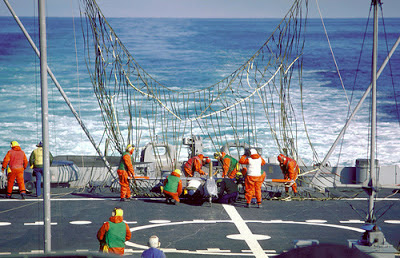This Month in History - RPV Targeting During Desert Storm
The U.S. military takes unmanned air vehicles for granted as they have been ubiquitous over the battlefield for the past decade. But it wasn't too long ago they UAVs were an unproven novelty in combat. The Naval History and Heritage Command website has chronicled the myriad of ways that remotely piloted vehicles operating off U.S. battleships were used to support Navy and Marine Corps operations during Desert Storm this month 22 years ago.
On 3 February, RQ-2A Pioneers from the USS MISSOURI (BB-63) were used for the first time to spot naval gun-fire when the ship "fired eight 1.25-ton shells from its 16-inch guns at prefabricated concrete command and control bunkers Iraq was moving into Kuwait, destroying the bunkers. The barrage, totalling 18,000 pounds of high explosives, marked the first combat firing of the MISSOURI's 16-inch guns since the Korean War, and was in support of Marines and coalition ground forces."
On 7 February, "USN A-6s attacked and heavily damaged 2 Iraqi patrol boats in the northern gulf near the A1 Faw peninsula. Using Remotely Piloted Vehicle (RPV) for spotting."
The next day, "USS WISCONSIN attacked a dozen Iraqi artillery emplacements with 36 rounds of its 16-inch guns in support of a Marine reconnaissance probe into occupied Kuwait. Using its remotely pilot vehicle to visually relay pictures and gun-firing coordinates of targets, the battleships's harassment and interdiction mission was designed to pin down and confuse Iraqi gunners during the Marine attack."
 On 26 February, near the end of the lightning fast ground war, "using Remotely Piloted Vehicles and Marine spotters ashore to zero-in on targets, including artillery, mortar and missile positions, ammunition storage facilities and a Silkworm missile site, battleships USS WISCONSIN and USS MISSOURI have fired more than 1000 rounds of 16" ammunition in support of ground operations. USS MISSOURI alone fired more than one million pounds of ordnance. USS WISCONSIN's RPVs provided on-site reconnaissance support from 11 nautical miles out for advancing Marines."
On 26 February, near the end of the lightning fast ground war, "using Remotely Piloted Vehicles and Marine spotters ashore to zero-in on targets, including artillery, mortar and missile positions, ammunition storage facilities and a Silkworm missile site, battleships USS WISCONSIN and USS MISSOURI have fired more than 1000 rounds of 16" ammunition in support of ground operations. USS MISSOURI alone fired more than one million pounds of ordnance. USS WISCONSIN's RPVs provided on-site reconnaissance support from 11 nautical miles out for advancing Marines."

The following day, "while off Kuwaiti coast, to assist ground forces to secure and enter Kuwait City, USS WISCONSIN's Remotely Piloted Vehicle detects 2 small boats fleeing Faylaka Island. Navy A-6s were called in and destroyed the boats, believed to be carrying Iraqi secret police."
This important point in history foreshadows more recent UAV tactics in Iraq, Afghanistan, and elsewhere supporting ground, air, and naval forces.
 |
| RQ-2 Pioneer UAV after recovery in the catch net device on the fantail of the battleship USS Iowa BB-62. (Official USN Photo) |
On 7 February, "USN A-6s attacked and heavily damaged 2 Iraqi patrol boats in the northern gulf near the A1 Faw peninsula. Using Remotely Piloted Vehicle (RPV) for spotting."
The next day, "USS WISCONSIN attacked a dozen Iraqi artillery emplacements with 36 rounds of its 16-inch guns in support of a Marine reconnaissance probe into occupied Kuwait. Using its remotely pilot vehicle to visually relay pictures and gun-firing coordinates of targets, the battleships's harassment and interdiction mission was designed to pin down and confuse Iraqi gunners during the Marine attack."
 On 26 February, near the end of the lightning fast ground war, "using Remotely Piloted Vehicles and Marine spotters ashore to zero-in on targets, including artillery, mortar and missile positions, ammunition storage facilities and a Silkworm missile site, battleships USS WISCONSIN and USS MISSOURI have fired more than 1000 rounds of 16" ammunition in support of ground operations. USS MISSOURI alone fired more than one million pounds of ordnance. USS WISCONSIN's RPVs provided on-site reconnaissance support from 11 nautical miles out for advancing Marines."
On 26 February, near the end of the lightning fast ground war, "using Remotely Piloted Vehicles and Marine spotters ashore to zero-in on targets, including artillery, mortar and missile positions, ammunition storage facilities and a Silkworm missile site, battleships USS WISCONSIN and USS MISSOURI have fired more than 1000 rounds of 16" ammunition in support of ground operations. USS MISSOURI alone fired more than one million pounds of ordnance. USS WISCONSIN's RPVs provided on-site reconnaissance support from 11 nautical miles out for advancing Marines."The following day, "while off Kuwaiti coast, to assist ground forces to secure and enter Kuwait City, USS WISCONSIN's Remotely Piloted Vehicle detects 2 small boats fleeing Faylaka Island. Navy A-6s were called in and destroyed the boats, believed to be carrying Iraqi secret police."
This important point in history foreshadows more recent UAV tactics in Iraq, Afghanistan, and elsewhere supporting ground, air, and naval forces.

Comments
Post a Comment